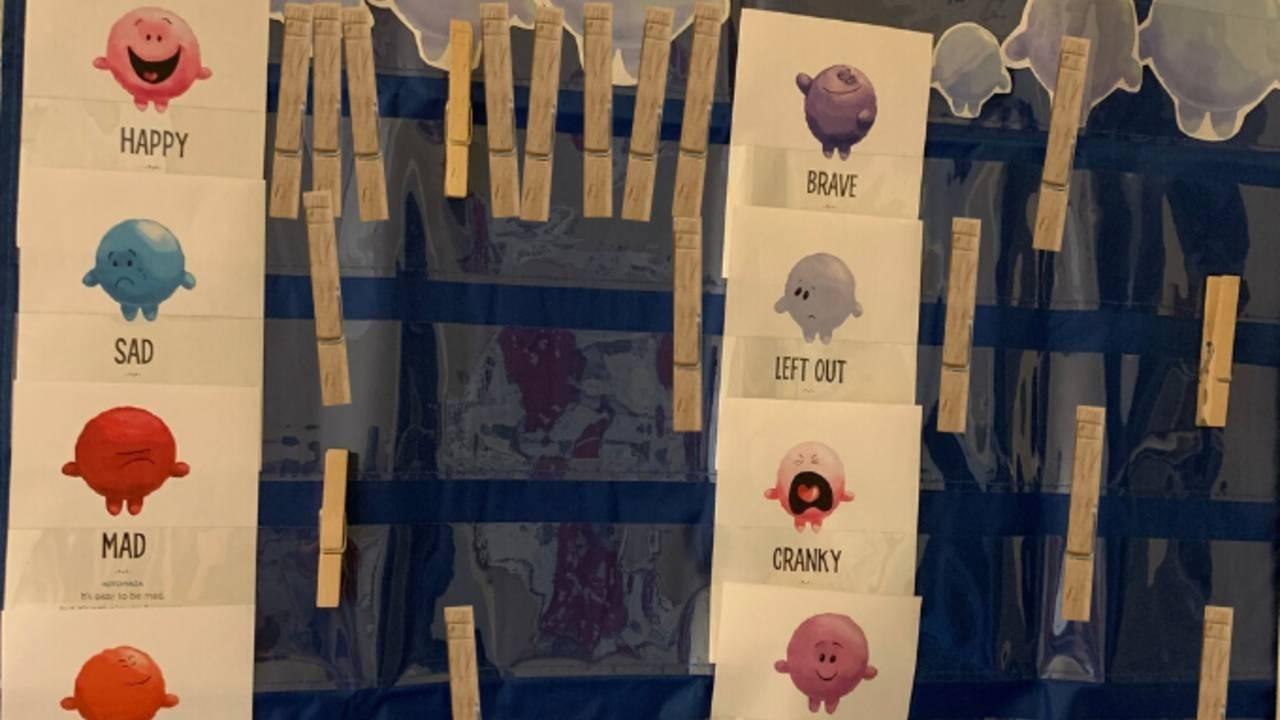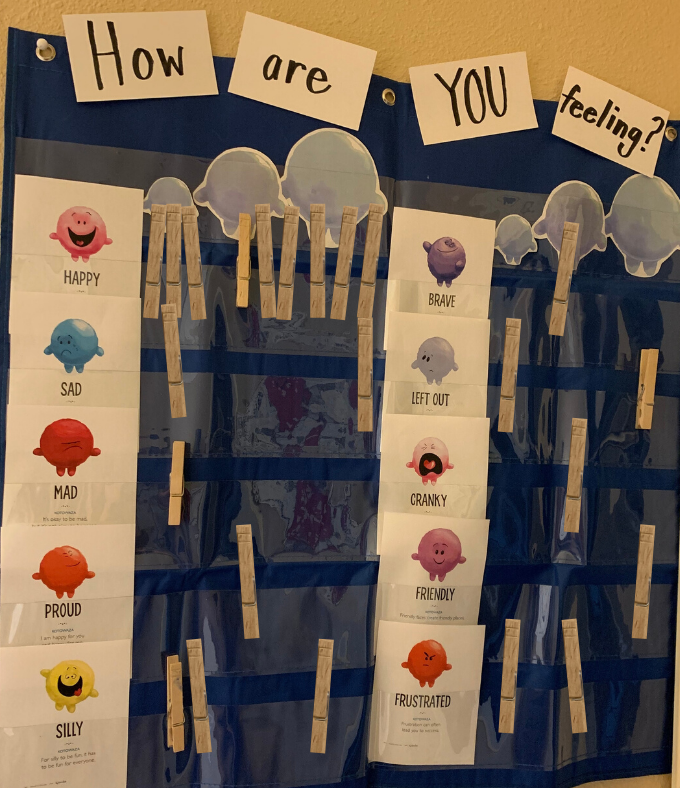
Feeling Check-ins as a Tool to Support Social and Emotional Learning and the Building of Positive Relationships.
by Katie Raher, PhD, PPS
I was in a class recently doing a Social and Emotional Learning (SEL) lesson, and I had an upper elementary aged child tell me, “I don’t do feelings.”
I wasn’t that surprised, since society often tells us not to “do feelings” or keeps us moving so quickly that we skip over the messages feelings are sending us.
I’m here to suggest we slow down and keep “doing feelings” because of the many benefits of being more self- and socially aware, and because of how vital feelings are to our self-regulation, decision making, and relationships.
One way to help students learn more about and accept the validity of feelings is to use Feeling Check-ins throughout the week, or perhaps at the start of each day or during other moments of the day.
There are so many creative possibilities for Feeling Check-ins. And having children have an opportunity to communicate what they're feeling by showing, rather than speaking, can be a great way to have every kid have a chance to "do feelings."
Here is one such Feeling Check-in Activity I recently co-created with an elementary school teacher for her classroom.

Here’s how it works…
- Each kid can put up their clothespin (or popsicle sticks or whatever works with what you’ve got on hand) on the feeling they’re having as they enter school that day. The teacher I just helped does a morning greeting with each child as they walk into school each day, and now each child is able to also communicate what’s going on for them in a simple, fast, fun, and free way.
- Kids can put their names forward or backwards, depending on how comfortable they feel with owning and sharing their feeling in the moment. The age, grade, socialization, and climate in the group are all factors that could contribute to this.
- You can adjust the number of feelings as part of the check-ins, depending on the needs of your group. You can also offer a blank feeling option so children can respond with new and more nuanced feeling words and build their emotional vocabulary. Kids can easily write or draw their other feeling on a post-it and pop it on the chart. Or perhaps they will leave it blank, if they don't know what they're feeling or feel empty or numb - an important thing to know about.
- You can encourage each kid to start thinking about the size of their feeling. “Is what I’m feeling small, medium, big, somewhere in between, or off the charts?” They can put their clip wherever feels right.
- You can encourage each kid to tune in to how they’re feeling at other parts of their day, so they start to notice that feelings come and go and can change in size. Might they move their clip to show a different size? Or move it to a different feeling all together? Because feelings can be messy and complex, kids may even ask for an extra clip, because it's not always as simple as just one feeling.
- You can also add your own clothespin and do think alouds, showing your students how you tune into and respond to feelings.
“I’m feeling really cranky this morning. I stayed up way too late last night, and I’m going to have to take a lot of extra calm down breaths to help me manage my cranky feelings in kind ways. I’d love for you to give me extra reminders and offer me a redo if I come across as cranky today.”
“My frustrated was really big for a while when you guys were getting so silly during work time, and after I told you I was feeling frustrated and needed you to quiet down, you did, so my frustrated got smaller and smaller and is now gone. Now I’m feeling happy, so I'll move my clip over here.”
There are advantages to allowing kids (and adults for that matter) to show, rather than tell, what they’re feeling, and to observe the range of others' feelings. So many more kids (and adults) may open up – even the ones that don’t “do feelings,” at least in public or at least not yet.
A feeling check-in like this provides all kids – the introverts and extroverts, the enthusiastic or hesitant, those who are neurotypical or neurodiverse, the boys and the girls and everyone in between – an opportunity to feel heard and seen. This may be your students’ favorite and/or most important part of their day.
They are likely to experience growth in social and emotional learning competencies that will contribute to short- and long-term benefits for students in school and life. When students are asked to do feeling check-ins, they can gain self-awareness, a foundation for self-regulation, as well as social awareness and a boost in their potential ability to make responsible decisions and have more positive relationships with others.
Feeling check-ins can certainly provide an important foundation for establishing positive relationships between us and our students, and most everything in schools goes more smoothly once you’ve got that going on!

While the simple act of asking our students to nonverbally communicate what’s going on for them can be powerful in and of itself, we can also use what we learn at these check-ins to connect with our kids in the ways they need.
Our additional responses are likely to provide even more fuel for the relationship and resilience building process.
- If a child's feeling left out, we can take steps to make them feel more included today – maybe we give them special helper jobs where they work with a kind classmate, ask them what they did the night before, ask for their input on an important task, or facilitate some connections with peers, especially ones who reported feeling friendly that day.
- If a child's feeling sad, then we might make sure they know we’re here if they need to talk or want a hug, have more patience for them if they’re having more trouble focusing than usual, or make sure they feel connected to a kind friend that day.
- If a child's feeling proud, we might check in about what’s been going so well and let them know we see their effort and growth and are proud of them too.
The list can go on and on, and the possibilities of responses are endless. You know your kids best, and I’m sure you can get creative in how you respond.
Even if you don’t have time or energy to “do” anything, your ability to attune and respond to your students’ needs is highly likely to grow when you have a greater understanding of what’s going on for students emotionally. That alone is likely to lead to some positive shifts.
If you're feeling curious how it's going in the classroom with this chart, the teacher has reported that her students seem calmer, more connected, and more engaged now that she does the feeling check-ins. And for that, she is reporting very big happy and proud feelings!
So... what might you try for Feeling Check-ins in your classroom or office? How might you use or modify the Feeling Check-in above?
Do you want tools to help you do check-ins and reflections with the children you support? Here are some possibilities...
- If you want the posters I used for the pocket chart, you can get them for free on the Kimochis® website.
- You may also enjoy this Free Feeling Reflection handout, which will allow you another way to help kids process feelings.
- Of course there is a ton more you can do for Feeling Check-ins when you have the Kimochis® Feeling Pillows...

If you're feeling curious about these awesome pillows and the whole powerful SEL program that goes with them, I’m a Kimochis® Certified Trainer, and I'd love to teach you all about them.
You can…
- learn more about why feelings matter, how feelings connect to behavior, and the 7 Kimochis® Keys to Communication - which are positive communication habits that can transform how kids communicate their feelings by joining the 10-Day SEL Training Series
- learn the entire Kimochis curriculum at your own pace from anywhere in the world if you join the Elementary Kimochis® Workshop On-Demand Course (curriculum must be purchased separately)
- attend a live Kimochis® workshop
- email [email protected] to arrange a workshop for your team
No matter what - if you use free resources or indulge a little on the Kimochis Feeling Pillows - I hope you are feeling EXCITED to start trying out some feeling check-ins with your kids.
Grab a Free Self-Compassion Poster +
stay connected for Constant Love & Learning news and updates!
We won't ever share your info with anyone, and you can unsubscribe at any time.


